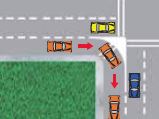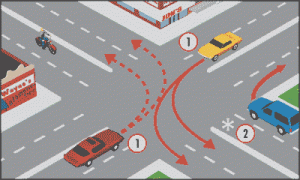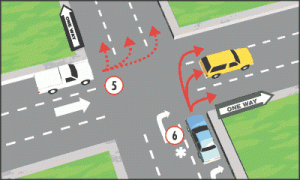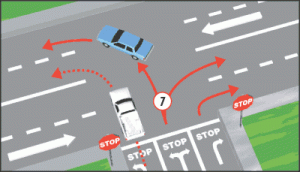Left turns– To make a left turn, drive close to the center divider line or into the left turn lane. Begin signaling
about 100 feet before the turn. Look over your left shoulder and reduce your speed. Stop behind the limit line. Look left, then right, then left again, and make the turn when it is safe. When you turn left, do not turn too soon and “cut the corner” of the lane belonging to the vehicles coming towards you.
Example of a left turn

Important: Keep your wheels pointed straight ahead until it is safe to start your turn. If your wheels are pointed to the left and a vehicle hits you from behind, you could be pushed into oncoming traffic. A left turn against a red light can only be made from a one-way street onto a one-way street. Signal and stop for a red traffic light at the marked limit line. If there is no limit line, stop before entering the crosswalk. If there is no crosswalk, stop before entering the intersection. You may turn left into a left-moving, one-way street if there is no sign to prohibit the turn. Yield to pedestrians, bicyclists, or other vehicles moving on their green light.
Right turns–To make a right turn, drive close to the right edge of the road. If there is a bike lane, drive into the bike lane no more than 200 feet before the turn. Watch for pedestrians, bicyclists, or motorcyclists who may get between your vehicle and the curb. Begin signaling about 100 feet before the turn. Look over your right shoulder and reduce your speed. Stop behind the limit line. Look both ways and turn when it is safe. Do not turn wide into another lane. Complete your turn in the right lane.
Example of a right turn:


200 feet is over half the length of an American football field.
Public Transit Bus Lanes–It is illegal to drive, stop, park, or leave a vehicle standing in the area of a road designated for the exclusive use of public transit buses unless a vehicle must cross the lane to make a turn. Signs will be posted to indicate the lanes are for “bus only” use.
Right turn against a red traffic signal light–Signal and stop for a red traffic signal light at the marked limit line. If there is no limit line, stop before entering the crosswalk. If there is no crosswalk, stop before entering the intersection. You may turn right if there is no sign to prohibit the turn. Yield to pedestrians, motorcyclists, bicyclists, or other vehicles moving on their green traffic signal light.
Right turn onto a road with a dedicated lane–You may make a right turn without stopping if the road you are turning onto has a nonmerging lane dedicated to right turning vehicles, and there is no sign to prohibit a free right turn. You may proceed without stopping, even if there is a red traffic signal light located within the island for vehicles proceeding straight through the intersection. If there is a traffic signal light or sign on the right curb of the right turn lane, you must follow the directions of that traffic signal light or sign. Always yield to pedestrians within a crosswalk.

No turn against a red arrow–You may not turn right or left against a red arrow.
Examples Of Right and Left Turns
Numbers on the cars in the diagrams refer to numbered sentences on these pages. Always use your turn signals.
1. Left turn from a two-way street. Start the turn in the left lane closest to the middle of the street. Complete the turn, if safe, in either lane of the cross street (shown by the arrows). Use the center left turn lane if one is available. A left turn may be made from the other lane, if permitted by signs or arrows.

2. Right turn. Begin and end the turn in the lane nearest the right edge of the road. Do not swing wide into another lane of traffic. Watch for pedestrians, motorcyclists, and bicyclists between your vehicle and the curb. Sometimes, signs or pavement markings will let you turn right from another lane as shown by the graphic.
3. Left turn from a two-way street into a one-way street. Start the turn from the lane closest to the middle of the street. Turn into any lane that is safely open, as shown by the arrows.

4. Left turn from a one-way street into a two-way street. Start the turn from the far left lane. Turn into either of the lanes that are safely open, as shown by the arrows.
5. Left turn from a one-way street into a one-way street. Start the turn from the far left lane. Watch for pedestrians, motorcyclists, and bicyclists between your vehicle and the curb because they can legally use the left turn lane for their left turns. Turn into any lane that is safely open, as shown by the arrows.

6. Right turn from a one-way street into a one-way street. Start the turn in the far right lane. If safe, you may end the turn in any lane. Sometimes, signs or pavement markings will let you turn right from another lane, as shown by the graphic.
7. Turn at a “T” intersection from a one-way street into a two-way street. Through traffic has the right-of-way. You may turn either right or left from the center lane. Watch for vehicles, motorcyclists, and bicyclists inside your turn.

Legal U-Turns
A U-turn is turning your vehicle around in the street to go back the way you came. To make a U-turn, signal and use the far left lane or the center left turn lane. You may make a legal U-turn:
- Across a double yellow line when it is safe and legal.
- In a residential district:
- If there are no vehicles approaching you within 200 feet.
- Whenever a traffic sign, light, or traffic signal light protects you from approaching vehicles.
- At an intersection on a green traffic signal light or green arrow, unless a “No U-turn” sign is posted.
- On a divided highway, only if an opening is provided in the center divider.
Illegal U-Turns
Never make a U-turn:
- At or on a railroad crossing.
- On a divided highway by crossing a dividing section, curb, strip of land, or two sets of double yellow lines.
- Where you cannot see clearly 200 feet in each direction because of a curve, hill, rain, fog, or other reason.
- Where a “No U-turn” sign is posted.
- When other vehicles may hit you.
- On a one-way street.
- In front of a fire station. Never use a fire station driveway to turn your vehicle around.
- In business districts. Areas with churches, apartments, multifamily housing units, and public buildings (except schools) are also considered to be business districts. Turn only at an intersection, unless a sign prohibits it, or where openings are provided for turns.